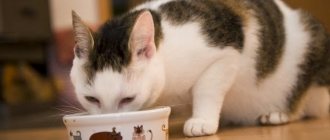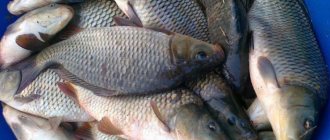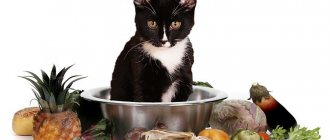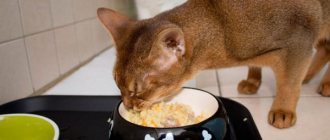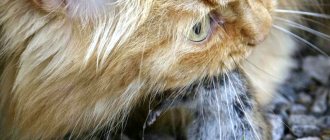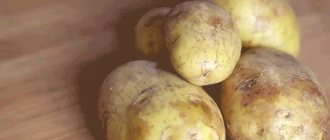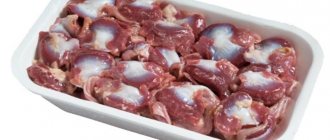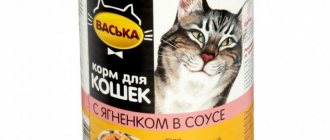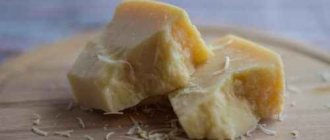All owners know that for the full development of their pets, first of all, care should be taken to ensure that their diet is balanced, that is, it contains all the necessary vitamins and minerals. You should not think that if you feed a cat meat every day, it will receive all the necessary nutrients; this is not true, since the animal’s menu should be varied, that is, it should include not only animal proteins and fats, but also plant foods.
Cats eat grass and some vegetables and fruits because they need extra vitamins and minerals. Apple is one of the most common fruits. Everyone knows how healthy it is; can it be included in a cat’s diet? How often can they be given apples, what benefits and what harm can they bring to the animal?
List of fruits and berries allowed for cats
Let’s clarify right away: before giving your cat a fresh treat, you need to remove all the bones and cut into small pieces. Apples, in addition, need to cut out the hard partitions and better peel them.
| Watermelon | A good source of extra fluid for cats who don't drink much in the heat. Remove the rind and all the seeds from a small piece of watermelon. Cut into cubes no more than 2 cm wide. |
| Melon | Like watermelon, a source of organic water and fiber. High content of folic acid, necessary for the prevention of inflammatory diseases. Carotene in melon (provitamin A) is a powerful antioxidant and immunostimulant that prevents the accumulation of free radicals in the body. |
| Pear | Source of pectin and fiber. It has a positive effect not only on intestinal function, but also strengthens the walls of blood vessels. |
| Strawberry | There is even more vitamin C in strawberries than in lemon. Berries generally hold the record for antioxidant content. In large quantities it can lead to difficulties with bowel movements and constipation. |
| Blueberry | Source of iron, vitamins C, group B and PP. Also contains tannins. Strengthens the immune system, has an astringent property and helps with diarrhea. |
| Gooseberry | The anti-inflammatory effect is provided by vitamins PP, C and B1. It has a slight laxative effect, so 1-2 berries will be enough as a treat. |
| Cherries and sweet cherries | Be sure to remove the seeds from the berries! They contain cyanide. Improve digestion, make it easier to digest heavy and fatty foods. |
| Peach | Remove the bone! Peach contains organic acids and soluble plant fibers. Soft peach is suitable as a treat for elderly pets. |
| Apple | It is best to take a green apple, it contains more vitamin C and pectin. Be sure to remove partitions and bones. Improves intestinal motility, but in large quantities can cause diarrhea. |
| Banana | A well-known source of potassium and magnesium, essential for heart function. Bananas are very high in calories and contain a lot of sugar and starch, so they should be given in smaller quantities than other fruits and berries. Long-term feeding can provoke the development of diabetes, so we do not recommend it as complementary food for overweight cats. |
| A pineapple | You can only give fully ripe pineapple and kiwi in small quantities. It’s rare that a cat will be tempted by products with such a bright aroma, but food manufacturers often add them to food. In canned food for cats, pineapple and kiwi are heat-treated and their content does not exceed 7%, so this is largely a marketing ploy and a minimal change in taste. |
| Kiwi |
You can give all other fruits and berries that are not very sour and rich in essential oils. Exotic tropical fruits : mango, mangosteen, rambutan, lychee and passion fruit can cause an allergic reaction. If your pet persistently asks for a piece of exotic food, cut off a piece of fruit the size of your little fingernail to check for food allergies.
There is a video on the Internet where, as a joke, cats are allowed to smell durian. Not every person is able to endure the monstrous smell of this fruit, so you should not mock cats with a more sensitive sense of smell.
Treats in the form of fresh fruits and berries can be given to your cat no more than 2 times a week!
Combination with other foods
According to veterinarians, vegetables and fruits should make up about 15% of a dog's total diet. For greater health benefits, you can puree apples and fresh carrots. It is also possible to prepare mixtures with pears or bananas. The latter should be slightly unripe.
In this form, it will be especially useful for puppies to eat apples. From fruit treats they will receive the nutrients necessary for their development.
Apricots and apples should not be combined. Both fruits are extremely high in fiber. Therefore, combining them can lead to diarrhea.
Eating pomegranate can lead to consequences in the form of gastritis. This is due to the high content of organic acids in this fruit.
Fruits and berries that are dangerous for cats
Your cat may ask you for something from the list below, but this does not mean that it is a completely safe product. Even in the absence of a visible reaction to the fruit, negative effects on individual organs or on the pet’s body as a whole can accumulate. This mainly manifests itself in rapid weight gain, decreased immunity and dental problems due to the high fructose content.
| Citrus fruits: orange, grapefruit, lemon, pomelo, tangerines | Cats are very sensitive to citrus essential oils. The peels of lemons and oranges are even used as protection against the encroachment of fluffy faces on flower pots. D-limonene is often included in organic sprays to discourage cats from marking their territory. Citrus acids, which are aggressive for cats, can cause nausea and vomiting. Orange and lemon, when consumed, will cause your pet to salivate profusely. |
| Grapes (raisins) | Very toxic product for dogs. The clinical picture of grape poisoning is characterized by vomiting, diarrhea and renal failure. The harm of grapes to cats has not been clinically proven; problems can only arise due to the consumption of a sufficiently large number of berries. There are isolated reports from cat owners about symptoms of grape poisoning similar to those in dogs, but this could very well be an allergy. |
| Avocado | A very high-calorie and fatty product for cats. It is especially dangerous if the cat wants to taste the avocado peel. It contains a toxin - persin. In cats, persin has the potential to cause heart damage. |
| Persimmon | Strong diuretic effect. Persimmon should not be given to neutered pets who have an increased risk of developing urolithiasis. Persimmon can be given in very small quantities only if the pet himself asks for this berry. |
If you do not find a product that interests you in the lists , then we adhere to the rule: you cannot give fruits and berries without removing the seeds, with a high content of essential oils, very sour and astringent in taste. For example, it is almost impossible to peel pomegranate from seeds, so it is better not to include it in your cat’s diet.
Let's summarize. There is no need to force your cat to eat fruits and berries. This is an additional complementary food if there is a lack of vitamins and microelements with natural feeding and a treat with a ready-made diet. If the cat has contraindications (obesity, allergies, diabetes), then any products are introduced into the diet with the permission of the veterinarian.
Apple vinegar
Apple cider vinegar is often used as a flea remedy . The risk of parasite infection almost always exists and it is quite difficult to avoid it. To protect animals from fleas, special collars and powders are produced. But the pesticides they contain can be unsafe not only for pets, but also for people.
Even the use of such products will not protect the animal from side effects, such as skin irritation, gastrointestinal diseases, etc. An alternative option is the use of apple cider vinegar.
Although he himself cannot kill fleas, they cannot stand his pungent smell and taste. Most likely, the ectoparasites will leave the animal treated with the solution and go looking for another victim. The easiest way to use the product is to spray it from a spray bottle.
Contraindications for feeding cats fruit
Diseases for which you should not include fruits and berries in a cat’s diet without the permission of a veterinarian:
- diabetes mellitus – fruits and berries are record holders for the content of sugars of natural origin, which is why they are very high in calories, and excess weight often provokes diabetes;
- obesity - fruits are very high in calories, so they definitely cannot be included in the diet of a losing weight pet;
- food allergies - if a cat has a sensitive type of gastrointestinal tract, she experiences vomiting, bad bowel movements, itching, sneezing or swelling to new foods, then you should not experiment. It is better to stick to a proven list of products; if it contains a sufficient amount of meat and additional vitamins, then there is no need to worry about a lack of nutrients.
If it gets bad
If you occasionally exceed the permissible portions of apples and applesauce, your animal may experience the following negative symptoms:
- due to excess fiber content in the body, the animal begins to lose weight;
- the appearance of colitis;
- stomach upset;
- fermentation;
- increased gas formation;
- diarrhea;
- dehydration.
A cat overfed with fruits must be urgently shown to a veterinarian to avoid negative consequences for its body.
Allergy to apples is a very rare manifestation, and animals are not susceptible to it. Therefore, if a cat begins to itch after eating a fruit, this is a sign of a low-quality product.
Apples purchased from the supermarket can be dangerous to animals due to the chemicals that have been applied to their skins to allow them to grow and ripen quickly. Often the fruit is covered with paraffin. This provides an attractive appearance, but can cause allergic reactions.
Apples in the diet of animals
Before considering an apple as one of the ingredients in pet food, let's look at its beneficial properties and harm to the body of pets. Can dogs eat apples and how do cats feel about these fruits? How much apples can be added to animals' diets?
The benefits and harms of apples
Can dogs have apples?
Considering the benefits and harm that an animal’s body can receive when eating a delicious fruit, apples can be given to a dog, but under certain conditions:
Why does he chew or lick the bag?
The main reason why a cat chews apples is an unbalanced diet. In addition to these fruits, the animal can eat grass, indoor plants or other vegetables and fruits.
Representatives of felines in the wild consume not only animal, but also plant foods. This is due to the fact that cats need coarse plant fibers. They improve digestive processes and saturate the body with essential vitamins. Thus, the pet, gnawing apples, simply tries to replenish the missing minerals and elements.
Most often, this problem can occur if the cat is fed food from the table. Human food is not entirely healthy for pets. Cheap food (Whiskas, Kitekat) is also harmful. It contains no vitamins and minerals, and even no meat (replaced with bone meal and food industry waste).
In this case, it is necessary to show the animal to a veterinarian. The doctor will examine the pet and give recommendations regarding its diet. You should choose only high-quality food, as close as possible to natural nutrition, enriched with essential vitamins and minerals.
After switching to high-quality food, there is every chance to wean your cat from gnawing apples without resorting to additional tricks.
Another reason why cats chew apples is boredom and lack of physical activity. If pets are not played with enough, then the accumulated excess energy is poured into exploring different corners of the apartment and playing with everything that can be found.
In this case, pieces of furniture, wallpaper and other things may also “suffer.” Bored animals are most attracted to wires. The less attention is paid to the pet, the more pronounced this behavior will be.
How to wean it off?
To stop a kitten from chewing wires, flowers and apples, you need to play with it regularly. Other methods will not have a long-term effect. After he grows up, the habit of chewing things can take hold and remain forever.
It is enough to play with an adult animal 2-3 times a day for 15 minutes. This will ensure an acceptable level of physical activity. The animal will no longer have the desire to play with foreign things and spoil them.
The following techniques will also help to wean your cat from gnawing apples and other objects:
- Use of protective equipment. For example, wires can be hidden using a corrugated plastic tube, flowers can be covered with mesh.
- Special repellers. As an option, devices that emit ultrasound when an animal approaches.
- Smell. Since cats do not like the aroma of aloe, citrus fruits, vinegar, you can treat things with them. The disadvantage of this method is that the smell will disappear quickly enough, and the items will have to be treated regularly.
Thus, a cat may be gnawing apples either from a lack of vitamins or simply from boredom. In order to wean her from this habit, the first step is to contact a veterinarian. And also regularly pay attention to the animal.
From the above, we can conclude that it is possible to give apples to healthy adult cats. In this case, it is necessary to adhere to the daily norm and give preference to fruits, mashed to a puree, adding it to the main dish.


